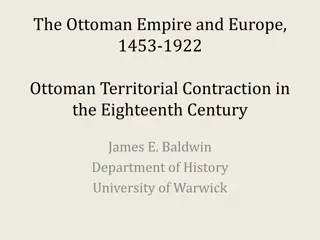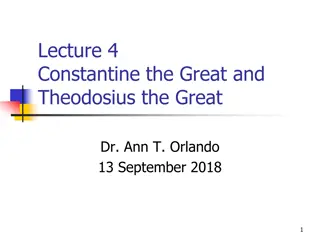Discovering the Rich History of Hampi: A Glimpse into the Vijayanagara Empire
Hampi, also known as Vijayanagara, holds the remnants of a once grand empire founded in the 14th century. The discovery of this historical site in 1800 by Colonel Colin Mackenzie marked the beginning of unveiling its treasures. From its origins under Harihara I and Bukka I to the golden era under Krishnadeva Raya, the Vijayanagara Empire's legacy is brought to life through ruins, inscriptions, and historical records. Explore the rise, reign, and decline of this fascinating civilization through Hampi's ancient structures and artifacts.
Download Presentation

Please find below an Image/Link to download the presentation.
The content on the website is provided AS IS for your information and personal use only. It may not be sold, licensed, or shared on other websites without obtaining consent from the author.If you encounter any issues during the download, it is possible that the publisher has removed the file from their server.
You are allowed to download the files provided on this website for personal or commercial use, subject to the condition that they are used lawfully. All files are the property of their respective owners.
The content on the website is provided AS IS for your information and personal use only. It may not be sold, licensed, or shared on other websites without obtaining consent from the author.
E N D
Presentation Transcript
Month: August Class: XII Subject: History Module: 1/2 Chapter: Seven (New Architecture Hampi) Topic-Discovering of Hampi Vijayanagara Teacher: B R MESHRAM , AECS No. 3 RBT
CONCEPTS: Discovery of Hampi Rayas, Nayakas and Sultans Kings and traders , Decline of Vijayanagara Empire and The rayas and the nayakas Vijayanagara : the capital and its Environs 1. Water resource 2.Fortification and roads 3.The urban centre The Royal centre Mahanavami dibba, Other building in the royal centre The sacred Centre- Choosing capitals, Gopurams and mandapas Plotting places, temple and Bazaars
INTRODUCTION- Vijaynagara or City of Victory was the name of both city and an empire. The empire was founded in the 14thcentury. Founder Harihara I and Bukka Capital of Vijayanagara Empire -Hampi It stretched from the river Krishna in the North to the extreme South of the peninsula . Rediscovery of Vijayanagara started with excavations at Hampi. Golden era of Vijayanagara empire was under the rule of Krishnadeva Raya.
THE DISCOVERY OF HAMPI : Hampi is another name for Vijayanagara Empire. The name Hampi is derived from the local mother goddess, Pampadevi. The ruins at Hampi were brought to light in 1800 by an Engineer Colonel Colin Mackenzie. An employee of the East India Company , he prepared the first survey map of the site. As early as 1836 , epigraphists began collecting several dozen inscriptions found at this and other temples at Hampi.
MAP 1-SOUTH INDIA C. 14TH-18THCENTURY:
SOURCES: Oral Inscriptions Manuscripts Other records helped historian to reconstruct the history of Vijayanagara Empire.
ORIGIN- Harihara I and Bukka I establishment the Vijaynagara empire on the bank of the river Tungabhadra in the year 1336. Four dynasties of Vijayanagara empire were 1. Sangam 2. Saluva 3. Tuluva 4. Aravidu The first Dynasty , known as the Sangama dynasty exercised control till 1485. They were replaced by the Saluvas , military commanders who remain in the power till 1503. Then they were replaced by the Tuluvas.
RAYAS,NAYAKAS AND SULTANS- According to the tradition and epigraphic evidence two brothers Harihara and Bukka , founded the Vijayanagara Empire1336. This empire included within its functioning Frontiers people who spoke different languages and followed different religious traditions.
KINGS AND TRADERS IN VIJAYANAGARA- As warfare during this time depended upon the effective cavalry, the import of horses from Arabia and central Asia was very important for rival kingdom. Trade was initially controlled by Arab merchant. from 1498, others actors appeared on the scene. These were Portuguese, who arrived on the west coast of the subcontinent and attempted to establish trading and military stations. Vijaynagara was also noted for its markets, dealing in spices, textile and many precious stone.
VIJAYANAGARA UNDER THE RULE OF KRISHNADEVA RAYA - Krishnadeva Raya s rule (1509-1529) was characterized by full expansion and consolidation. He brought under his control the land between Tungabhadra and Krishna river called Raichur doabs in the year 1512. He defeated Pratap Rudra of Gajpati dynasty, the ruler of Orissa in 1514 and Sultan of Bijapur in 1520. Krishnadeva Raya is credited with building some fine temple and adding impressive gopurams to many important South Indian temples.
DECLINE OF THE EMPIRE: After the death of Krishnadeva Raya in 1529 his successors had to face the challenges of rebel Nayakas. by 1542, the controlled of the empire come under another ruling lineage , the Aravidu. This dynasty remained in power till 17thcentury. During this period alignment kept on shifting due to military ambitions. These ambitions led an alliance of Deccan Sultanate. In 1565 Rama Raya , the chief minister of Vijayanagara led the army into battle of Rakshsi-Tangdi( also known as Talikota) ,where his forces routed by the combine armies of Bijapur, Ahmadnagar and Golconda. The victories armies sacked the city of Vijayanagara.
THE RAYAS AND THE NAYAKAS : Military chiefs usually controlled forts and had armed supporters. These chiefs often moved from one area to another and in many cases were accompanied by peasants looking for fertile land on which to settle. These chiefs were known as nayakas and they usually spoke Telugu or Kannada. Many nayakas submitted to the authority of the kings of Vijayanagara , but they often rebelled and had to be subdued by the military action.
AMARA- NAYAKAS: The amara-nayakas system was a major political innovation of the Vijayanagara Empire. It is likely that many features of this system were derived from the iqta system of the Delhi Sultanate. The amara-nayakas were military commanders who were given territories to govern by the raya. They collected taxes and other dues from peasant , craftsperson's and trader in area. The amara-nayakas sent tribute to the King annually and personally appeared in the royal court with gifts to express their loyalty.
ASSIGNMENT: What was the other name of the Vijayanagara city? When was Vijayanagara kingdoms established? Name the different dynasties which ruled over Vijayanagara? Who were Amara-Nayakas? State any two characteristics of Krishna Deva Raya s rule? State any two reasons for the decline of Vijayanagara empire? Why did the imperial power of Vijayanagara decline after the death of Krishna Deva Raya? Explain briefly any five striking features about the location of Vijayanagara?























